Abstract
Exploring the doping components of the coating is of great significance for improving the tribological properties of the MoS2-based coating. The optimization of magnetron sputtering process parameters can also improve the coating quality. In this paper, the effects of working gas flow rate on the microstructure in a vacuum chamber, nano-hardness, and tribological properties of Ce-Ti/MoS2 coatings were studied using DC and RF unbalanced co-sputtering technology. It is found that the coating structure was coarse and porous when the Ar flow rate was excessive (70 sccm), significantly affecting the mechanical properties; there are pit defects on the surface of the coating when the flow rate is just minor (30 sccm), and the coating easily falls off during the friction process. When the flow rate is 40~60 sccm, the coating grows uniformly, the hardness reaches 7.85 GPa at 50 sccm, and the wear rate is only 4.42 × 10−7 mm3 N−1 m−1 at 60 sccm. The coating doped with Ce and Ti is an approximate amorphous structure. Under appropriate gas flow rate conditions, the friction induces a transfer film with a layered structure, and the MoS2 (002) crystal plane orientation is arranged in parallel at the edge of the wear debris, effectively reducing the shear force during sliding and reducing wear. Based on rare earth doping, this study improves the tribological properties by optimizing the working gas parameters, which plays a reference role in preparing high-quality MoS2-based coatings.
1. Introduction
Transition metal dichalcogenides (TMDs) materials have a sandwich-layered structure. The adjacent two layers are connected by weak van der Waals, which reduces the shear strength between the layers [1,2]. It can be expressed as MX2 (M = Mo, W; X = S, Se). Among them, MoS2 coating can be used for long-term and stable use under harsh conditions such as high load, high-low temperature, and high vacuum, and is widely used in critical moving parts in ground and space environments. However, the mechanical properties of pure MoS2 coatings are poor, and the loose structure is easy to combine with water and oxygen to form MoO3 [3]. Therefore, MoS2 coatings have significant performance differences in different application environments.
To solve the problem of low bearing capacity and limited application range of pure MoS2 coating, component doping of MoS2-based coating is a typical improvement method. At present, various metal and non-metal elements, such as C, N, Cu, Si, Ta, Ag, Zr, and Ti [4,5,6,7,8,9,10,11], as well as compounds such as TiN and Al2O3 [12,13], have been studied for doping MoS2 coatings to improve wear resistance. Among them, metal doping can induce the growth of MoS2 coating with (002) preferred orientation, and the coating structure is more compact, improving the film’s wear resistance. On the other hand, due to the preferential oxidation of some metal elements, the oxidation of MoS2 on the contact surface and the destruction of the layered structure are prevented, and the oxidation resistance of the MoS2 coating is improved [14].
In addition, as a highly anisotropic material, MoS2 is very sensitive to the preparation process parameters. The process parameters of MoS2 composite coating prepared by unbalanced magnetron sputtering, such as deposition pressure, sputtering target power, workpiece bias, and gas flow rate, can affect the crystal orientation and coating density of MoS2 and then change its tribological properties, mechanical properties, and catalytic properties [15,16,17]. Therefore, improving the process is also essential to improving the performance of MoS2-based coatings. Kokalj et al. [18] studied the structural changes of MoSx films under pulse frequency and other parameters. They found that low pulse frequency shortened the Mo-S bond length, which could significantly improve the hardness and elastic stiffness of the film. Tillmann et al. [19] used HiPIMS to prepare MoSx films and studied the influence of bias voltage and deposition pressure parameters. It was found that a low deposition rate was beneficial to the growth of the (002) basal plane, while high kinetic energy caused by high bias voltage promoted the growth of the (100) basal plane of the coating. These studies have analyzed the influence of parameters on the coating structure and application performance from the perspective of sputtering particle kinetic energy. In the chamber of PVD coating, in addition to sputtering power, the pressure and flow rate of working gas are also the main factors affecting the energy of sputtering particles. At present, the research on gas flow rate focuses on the process of reactive magnetron sputtering, involving the influence of the flow rate ratio of reactive gas and argon on the reaction products of the coating [20,21]. At the same time, there are few studies on the flow rate of a single working gas.
Nowadays, the research of doped metals in surface engineering has been widely involved in rare earth elements. They have the effect of regulating optical and magnetic properties [22,23,24]. In addition to the thermal barrier function [25,26], their oxidation products are also used to regulate grain growth and slow down sliding wear [27]. For MoS2-based coatings, there are few studies on the improvement of tribological properties of rare earth multi-doped coatings, and the influence of process improvement, especially working gas flow, is also rare. Therefore, in this paper, binary doped Ce-Ti/MoS2 coatings were prepared by co-sputtering Ce-Ti alloy and MoS2 using unbalanced magnetron sputtering equipment. The effects of argon flow rate on the structure, mechanical properties, and tribological properties of the coating were studied, which provided ideas for improving the preparation process of MoS2-based coating and the wear resistance of the coating.
2. Materials and Methods
2.1. Coatings Preparation
Ce-Ti/MoS2 composite coatings were deposited by an unbalanced magnetron sputtering system (JGP045CA, SKY, Shenyang, China). MoS2, Cr, and Ce-Ti alloy(1:1) targets were used as sputtering targets. Monocrystalline silicon was used to test composite coatings’ mechanical properties and section images; 9Cr18 steel was used to test the friction, wear properties, and surface morphology of composite coatings. The 9Cr18 steel is polished and cleaned to ensure a surface roughness of Ra ≤ 0.2 μm. Before sputtering, a 10 min Cr transition layer was deposited on the substrate before Ce-Ti/MoS2 composite coatings to improve the adhesion of Ce-Ti/MoS2 composite coatings. Then, Ce-Ti/MoS2 composite coatings were deposited at different Argon flow rates by co-sputtering the Ce-Ti alloy target and MoS2 target. The specific process parameters are shown in Table 1.

Table 1.
Preparation parameters of each sample.
2.2. Characterization Analysis
FESEM (field emission scanning electron microscopy, Sigma300, ZEISS, Jena, Germany) was used to observe the microstructure of coatings and analyze element distribution by EDS (Energy Dispersive Spectrometer) components. The crystal structure of the coatings was analyzed by GIXRD (grazing incidence X-ray diffractometer, Rigaku Smartlab 3 kW, Tokyo, Japan) with CuKα radiation. The composition of coatings was obtained by XPS (X-ray photoelectron spectroscopy, PHI-Vesoprobe 5000 III, Thermo Fischer, Waltham, MA, USA), the vacuum degree of the analysis room was 4 × l0−9 Pa with Al kα radiation (hv = 1486.6 eV). Working voltage and working current were 14.6 kV and 13.5 mA, respectively. The binding energies were corrected according to the standard of C1s peak at 284.8 eV. The morphology and structure of wear debris were observed by HRTEM (high-resolution transmission electron microscopy, Talos F200, FEI, Hillsboro, OR, USA). The samples used for HRTEM measurements were obtained by mechanical scraping on a Cu grid fitted with a carbon membrane. The microhardness and elastic modulus of Ce-Ti/MoS2 composite coatings were analyzed using nanoindentation (iNano, KLA, Ann Arbor, MI, USA). Berkovich indenter was selected to test the single-point hardness on the monocrystalline silicon. To avoid the test error, five different positions were tested, the average value of the test results was taken, the test load was 10 mN, and the maximum indentation depth was set to be no more than 1/10 of the coating’s thickness.
2.3. Tribological Tests
The friction and wear properties of Ce-Ti/MoS2 composite coatings were tested on a friction and wear testing machine in the atmospheric environment. The friction mode was circular sliding friction under dry friction. Sliding wear tests used 2.4 N normal loads, 1000 r/min and 9Cr18 ball (Ф 6 mm) as the counterpart. The sliding time was set at 20 min in an environment with a humidity of 50%RH.
A three-dimensional white light interferometer (Rtec, San Jose, CA, USA) was used to measure the cross-section morphology of the wear marks, and the cross-sectional area was obtained by integration. The wear volume was obtained by multiplying the total length of the wear mark, and the wear rate (W) was calculated according to the formula W = V/(F × L). In the formula, W is the wear rate (mm3 N−1 m−1), V is the wear volume (mm3), F is the applied normal load (N), and L is the total friction stroke (m). To reduce the error, the average wear rate of 5 times was calculated as an index to measure the wear resistance of the coating.
3. Results and Discussion
3.1. Morphology and Microstructure
Figure 1 shows the surface and cross-section images of Ce-Ti/MoS2 composite films at different Ar flows. Different from the morphology of pure MoS2 [28], a porous and fiber-like surface in the report, the Ce-Ti/MoS2 coating exhibits cauliflower-like; there are pores between multiple uplifts. The cross-section morphology in Figure 1a is porous sponge-like, and signs of columnar growth perpendicular to the substrate can be observed; there are also many sputtering defects on the surface. In addition to the surface roughness and large pores, the agglomeration size is also uneven. The surface of Figure 1c,d is smooth, and the grain size is small, which plays the role of fine grain strengthening. When the argon flow rate increases to 70 sccm, large particles appear on the surface of the Figure 1e coating, indicating that the sputtering particle energy is low and the coating is difficult to grow densely.

Figure 1.
Surface and Cross-section FESEM micrographs of the composite coatings. (a) 30 sccm, (b) 40 sccm, (c) 50 sccm, (d) 60 sccm, (e) 70 sccm.
The content of doped elements and oxygen was counted in Table 2. It was observed that the change in the percentage of doped metal atoms caused by the change in the Ar flow rate was not obvious, and the sputtering efficiency of the Ti element was significantly higher than that of the Ce element. It is worth noting that the presence of O element was also found in the Ce-Ti/MoS2 coating, and the content was relatively low when the flow rate was 60 sccm. The analysis shows that the oxygen content of the coating is mainly related to the content of the doped metal elements and the growth structure of the coating. The Ti element doped in the composite coating will generate oxide TiO2 [29]. Ce, as a rare earth element with very active chemical properties, makes it easy for O to generate oxide CeO2 and Ce2O3 [30]. On the other hand, the Mo element in the MoS2-based coating is also easily oxidized to MoO3 in the atmosphere. At 60 sccm, the coating structure is dense, which can effectively curb the further reaction of H2O and O2 in the atmospheric environment with the coating, so the content of the O element is relatively reduced. In addition, the coating thickness also shows a trend of thickening first and then thinning with the increase of the Ar flow rate, indicating that an appropriate Ar flow rate (40~60 sccm) can significantly improve the deposition efficiency.

Table 2.
Chemical composition and thickness of coatings.
According to the morphology and element content, the change in the Ar flow rate mainly affects the energy of sputtering particles and finally makes the quality of the finished coating different [31]. The analysis of the sputtering process in the vacuum chamber shows that the increase of the Ar flow rate increases the ionization amount of argon, the voltage will decrease under constant sputtering power, and the initial kinetic energy of the emitted particles will decrease. This phenomenon will cause some target components cannot be attached to the substrate, reducing the deposition efficiency and making the coating structure coarse and porous. On the other hand, when the working gas flow rate is too low, the particles with too much kinetic energy will collide and reflect when they reach the substrate. In addition, when the Ar flow rate is too low, the particle bombardment on the film’s surface is intense, which will also lead to an increase in the surface temperature of the film and the reaction with the residual gas. On the other hand, it will destroy the orderly growth of the film and cause surface defects.
3.2. Mechanical Properties
Hardness and elastic modulus are important indicators affecting the mechanical properties of the coating and prominently influence the tribological properties. Therefore, the nanoindentation hardness and elastic modulus of the deposited coating were measured by nano-indenter, as shown in Figure 2. Compared with pure MoS2 coating, the doping of Ce and Ti significantly increases the coatings’ microhardness and improves the coatings’ bearing capacity. The hardness of the coating is almost proportional to the elastic modulus at each Ar flow rate and increases first and then decreases with the increase of the Ar flow rate; the nano-hardness of 50 sccm is the largest, which is 7.85 GPa, and the elastic modulus is 134.99 GPa. According to the data in Table 2, the sputtering efficiency of the doped element at 50 sccm is relatively high, and the solid solution strengthening effect is more obvious. In addition, according to Hall-Petch theory [32], the hardness increase is also related to grain boundary strengthening. When the argon flow rate is 70 and 30 sccm, the hardness of the sample is only 5.94 and 5.49 GPa, respectively. According to Figure 1, the coating defects and large pores are the main factors for low hardness.
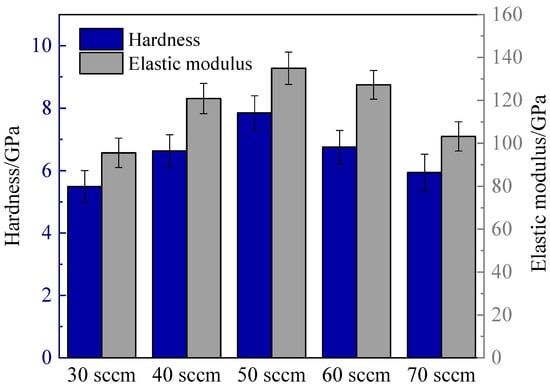
Figure 2.
Hardness and elastic modulus of the composite coatings deposited at different Ar flows.
3.3. Phase Analysis
Figure 3 presents the X-ray diffraction patterns of coatings over the 2θ, ranging from 5° to 90°. No pronounced diffraction peak in the spectrum indicates that the Ce-Ti/MoS2 coating is in an approximate amorphous state. Compared with pure MoS2 coating [3,33], the characteristic peaks of MoS2 with (100), (105), and (110) orientations are not obvious, and only the peak of (002) crystal plane growth is left. This growth mode can reduce the number of dangling bonds on the coating surface and effectively organize the oxidation failure of the coating. The peak of MoxSy (0.5 < x:y < 1) was found at a low Ar flow rate (PDF card: No. 51-1004, No. 27-0319), indicating that the S/Mo is less than 2 in the sputtering environment with a large Ar flow rate, and some of the S elements are not attached to the coating. This phenomenon generally occurs in the related research of MoS2 coating [34], mainly related to the preferential re-sputtering of S elements during the deposition process [35]. In addition, a weak rare earth oxide peak also appeared when the Ar flow rate was 40 sccm.
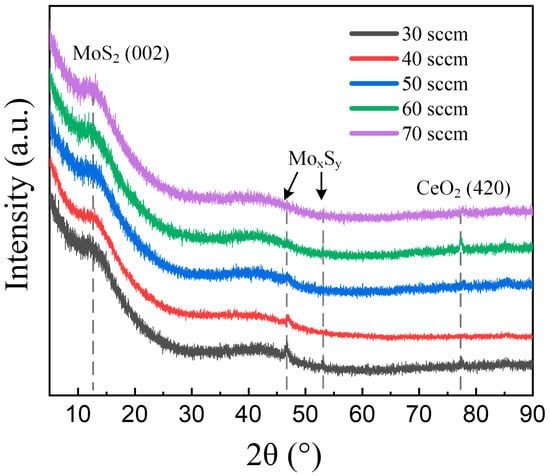
Figure 3.
XRD patterns of coating surface at different Ar flows.
The surface of the samples was scanned by XPS, and the spectra of Mo 3d, S 2s, Ce 3d, and Ti 2p orbitals are analyzed, as shown in Figure 4. Except for a peak at the binding energy of 226.5 eV for all samples corresponding to S 2s [36], the Mo 3d and S 2s core lines presented in Figure 4 consists of two (3d5/2–3d3/2) and one (2s3/2–2s1/2) spin-orbit doublets, respectively. The peaks at near 229.0 eV and 232.2 eV are attributed to Mo4+ 3d5/2 and Mo4+ 3d3/2 of MoS2, respectively [37,38]; the peaks at near 232.9 eV and 236.0 eV are attributed to Mo6+ 3d5/2 and Mo6+ 3d3/2 of MoO3, respectively. The characteristic peaks of molybdenum oxides are generally due to oxygen adsorption by the dangling bonds on the coating surface. The peaks near 162.4 and 163.6 eV on the S 2p orbital are S 2p3/2 and S 2p1/2 peaks in MoS2 [39,40], corresponding to the Mo 3d orbital results. In addition, Mo, S, and O binding peaks were also detected in the 30 sccm sample, located near the binding energies of 162.6 and 163.7 eV.
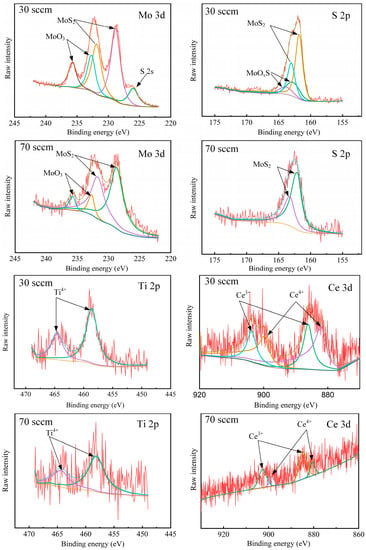
Figure 4.
XPS spectra of Ce-Ti/MoS2 coating.
In detecting doped metals, the Ce 3d and Ti 2p core lines presented in Figure 4 consists of two (3d5/2–3d3/2) and one (2p3/2–2p1/2) spin-orbit doublets, respectively. The peaks at 886.4 and 904.5 eV are attributed to Ce3+ 3d5/2 and Ce3+ 3d3/2 of Ce2O3, respectively [41]; the peaks at 882.3 and 900.4 eV are attributed to Ce4+ 3d5/2 and Ce4+ 3d3/2 of CeO2 respectively [42]. Furthermore, the peaks near 458.78 and 464.32 eV are Ti 2p3/2 and Ti 2p1/2 peaks in TiO2 [43]. It can be seen that the doped metals on the surface of the coating are easy to combine with O to form oxides, including Ce2O3, CeO2, and TiO2. Doped metals can usually prevent further oxidation inside the coating by preferential oxidation. Cerium oxide also inhibits grain growth, coarsening in the material, and assisting lubrication [44,45].
3.4. Tribological Behavior
The friction coefficient curves of the coatings prepared at different Ar flow rates are shown in Figure 5a. The friction coefficient of Ce and Ti-doped MoS2 composite coatings is generally low, and the flow rate can be stabilized at 0.1 and below. Among them, the friction coefficient is the lowest at 40 sccm, and the coefficient fluctuation in the stable friction stage is relatively stable. The addition of Ce and Ti is not only beneficial to the compactness of the coating structure but also retains the lubrication performance of MoS2 itself to a certain extent. The friction coefficient of the highest (70 sccm) and the lowest (30 sccm) flow rate in the experimental group was relatively the highest, and the friction coefficient of 40~60 sccm was kept at a low level, which was only 0.073 when the flow rate was 40 sccm. It is worth noting that the average friction coefficient increases slightly at 50 sccm. Due to the highest hardness of the coating under this process parameter (Figure 2), in addition to solid solution strengthening, the local enrichment of doping elements forms a pinning strengthening effect, which will interfere with the interlayer sliding of MoS2 [34].
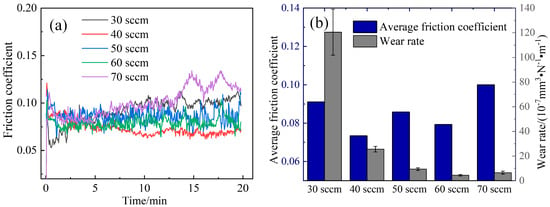
Figure 5.
(a) Friction coefficient curves of Ce-Ti/MoS2 coatings; (b) Wear rate of Ce-Ti/MoS2 coatings.
It can be noted from Figure 5b that the wear rate of the coating at 30 sccm is significantly higher than that of other parameter samples. At this time, the coating peels off the substrate. It is speculated from the time when the friction coefficient changes abruptly that the peeling occurs at about the 13th minute of friction. When the Ar flow rate increases to 40~60 sccm, the wear rate reaches the lower value gradually. Especially at 60 sccm, the wear rate is only 4.42 × 10−7 mm3 N−1 m−1. The wear rate increased slightly at 70 sccm, mainly due to the appearance of large particles on the surface (Figure 1). It is considered that the Ar flow rate makes the film growth relatively uniform during the sputtering process and retains more MoS2 coating structures parallel to the (002) crystal plane orientation of the substrate in the flow rate range of 50 to 70.
To further study the wear of the coating, the FESEM morphology and white light interference pattern of the wear track after the coating friction test were tested, as shown in Figure 6. The dark part of the SEM image in Figure 6a is a bare substrate, and the white light image shows that the edge of the wear track contour is perpendicular to the plane, which is approximately rectangular. It shows that the wear depth has penetrated the coating, and the failure mode is the film shedding. Figure 1a confirms that there are too many defects in the coating, and it is easier to form stress concentration at the surface depression under the action of cyclic force, which eventually causes structural damage to the coating. There are two typical wear characteristics when the flow rate is 40 sccm. The main wear area is the part with large Hertz contact stress between the steel ball and the coating. A furrow with a width of 156.9 μm is mainly abrasive wear, and the rest of the wear area is only slight scratches. The coating with a flow rate of 50~70 sccm has similar wear morphology, and the wear track is shallow and smooth. From the SEM image, small pits caused by adhesive wear at the wear track can be observed. When the flow rate is 60 sccm, the width of the wear track is the narrowest, only 119.6 μm.
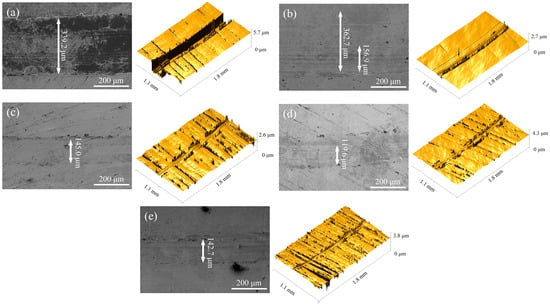
Figure 6.
Wear tracks morphologies and white light interferograms at different Ar flows. (a) 30 sccm, (b) 40 sccm, (c) 50 sccm, (d) 60 sccm, (e) 70 sccm.
The solid lubrication coating makes it easy to form a transfer film on the steel ball during the friction process, which has the effect of reducing the shear stress. Therefore, the wear spot of the steel ball is observed, and the EDS mapping is measured, as shown in Figure 7. When the flow rate was 30 sccm, parallel scratches were observed on the surface of the steel ball along the friction direction, and the composition of MoS2 was detected in the scratches. It shows that in the case of coating shedding, the wear debris in the wear scar and the transfer film on the steel ball can still assist lubrication, and the friction coefficient is stabilized within 0.15 (Figure 5). From Figure 7b–e, it can be observed that different degrees of transfer film appear on the steel balls with a flow rate of 40~70 sccm. The size of the transfer film with a flow rate of 60 sccm is the smallest, indicating that the contact area between the coating and the steel ball is small, and it is also confirmed that the wear rate is the lowest under this parameter. It can be seen from the Mapping diagram that the main components of the wear debris and the formed transfer film are Mo and S elements, and the content of doped metal elements is relatively low. In addition, the oxygen element also exists on the wear scar, mainly the oxides of doped metals (Ce, Ti) and MoO3 formed by the oxidation of MoS2.
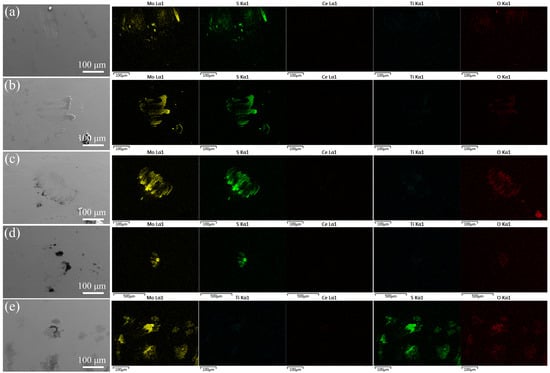
Figure 7.
SEM micrographs and EDS mapping images of the wear scars for (a) 30 sccm, (b) 40 sccm, (c) 50 sccm, (d) 60 sccm, (e) 70 sccm.
To further explore the morphology of the transfer film and wear debris on the wear scar and its role in the friction process, TEM was used to observe the wear debris on the steel ball, as shown in Figure 8. Figure 8a shows the morphology of wear debris. The wear debris scraped on the copper mesh is mainly located at the hole’s edge, in the form of sheet single-layer or multilayer stacking. The HRTEM image at high magnification is shown in Figure 8b. Many MoS2 layered crystals are observed, and the interplanar spacing is calculated to be 0.69 nm, which is the (002) crystal orientation of MoS2. The edge of the wear debris is different from the internal crystal arrangement: the MoS2 layered structure at the edge of the wear debris is parallel to the edge line arrangement, the yellow area forms multiple anisotropic nanocrystals, and the internal wear debris has turbulent structure. This structure also appears in the related research of Cu-doped MoS2 coating [34]. In addition, (100) oriented MoS2 nanocrystals with a facet spacing of 0.27 nm were also found to aggregate at the edge of the debris outside the red region. The analysis shows that MoS2 in the wear debris has a layered structure with (002) crystal plane orientation. The mechanical scratching and friction heat generated during the friction process will induce MoS2 crystals to be arranged in parallel within a specific range. This phenomenon can effectively reduce the shear stress of the friction process while preventing the oxygen element from penetrating into the interior.
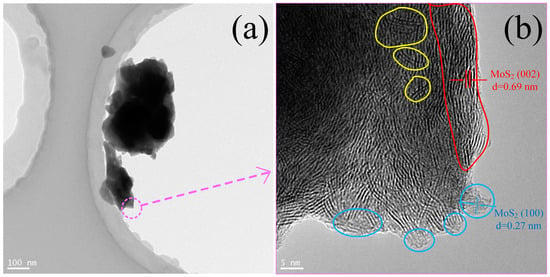
Figure 8.
HRTEM patterns at 60 sccm: (a) debris topography, (b) partial enlarged detail.
4. Conclusions
In summary, unbalanced magnetron sputtering equipment prepared the Ce-Ti/MoS2 coating by controlling the Ar flow rate in the range of 30~70 sccm. The Ar flow rate significantly affected the surface morphology of the coating. The sputtered particles had a suitable sputtering kinetic energy at a flow rate of 40–60 sccm, reducing the surface pores and compacting the structure. The elastic modulus and hardness of the coating increase first and then decrease with the increase of the Ar flow rate. The coating has the highest hardness of 7.85 GPa at 50 sccm due to grain boundary and solid solution strengthening. The coating doped with Ce and Ti is similar to the amorphous state, and only the weak (002) crystal orientation of MoS2 is found. The doping elements in the surface layer exist in the form of metal oxides, which can ensure the integrity of the internal MoS2 structure by preferential oxidation. Due to the surface defects caused by particle bombardment, the low Ar flow sample is prone to coating shedding during friction. The wear rate of the coating is minimum when the flow rate is 60 sccm, and there is no obvious furrow during the friction process, only minor adhesive wear marks. This phenomenon is due to the transfer film on the steel ball under the induction of friction. A layered structure parallel to the substrate reduces the shear force during sliding.
Author Contributions
Conceptualization, Y.X.; Data curation, C.T.; Formal analysis, C.T.; Project administration, H.C. and Y.Y.; Resources, Y.X.; Writing—original draft, C.T. and L.P.; Writing—review & editing, H.C. and Y.X. All authors have read and agreed to the published version of the manuscript.
Funding
This research was funded by the National Key Research and Development program, grant number 2021YFB3400400; Project of Science and Technology Development of Henan Province, grant number 202102210073.
Institutional Review Board Statement
Not applicable.
Informed Consent Statement
Not applicable.
Data Availability Statement
The authors confirm that the data supporting the findings of this study are available within the article.
Conflicts of Interest
The authors declare no conflict of interest.
References
- Prasad, S.; Zabinski, J. Lubricants: Super slippery solids. Nature 1997, 387, 761–763. [Google Scholar] [CrossRef]
- Vazirisereshk, M.R.; Martini, A.; Strubbe, D.A.; Baykara, M.Z. Solid Lubrication with MoS2: A Review. Lubricants 2019, 7, 57. [Google Scholar] [CrossRef]
- Xu, Y.; Xie, M.; Li, Y.; Zhang, G.; Zhu, M. The effect of Si content on the structure and tribological performance of MoS2/Si coatings. Surf. Coat. Technol. 2020, 403, 126362. [Google Scholar] [CrossRef]
- Ye, M.; Zhang, G.; Ba, Y.; Wang, T.; Wang, X.; Liu, Z. Microstructure and tribological properties of MoS2+Zr composite coatings in high humidity environment. Appl. Surf. Sci. 2016, 367, 140–146. [Google Scholar] [CrossRef]
- Yang, Y.; Zhao, Y.; Mei, H.; Cheng, L.; Zhang, L. 3DN C/SiC-MoS2 self-lubricating composites with high friction stability and excellent elevated-temperature lubrication. J. Eur. Ceram. Soc. 2021, 41, 6815–6823. [Google Scholar] [CrossRef]
- Liu, X.; Ma, G.J.; Sun, G.; Duan, Y.P.; Liu, S.H. MoSx-Ta composite coatings on steel by d.c magnetron sputtering. Vacuum 2013, 89, 203–208. [Google Scholar] [CrossRef]
- Li, H.; Zhang, G.; Wang, L. The role of tribo-pairs in modifying the tribological behavior of the MoS2/Ti composite coating. J. Phys. D Appl. Phys. 2016, 49, 095501. [Google Scholar] [CrossRef]
- Jing, W.; Du, S.; Chen, S.; Liu, E.; Du, H.; Cai, H. Tribological Behavior of VN-MoS2/Ag Composites over a Wide Temperature Range. Tribol. Trans. 2021, 65, 66–77. [Google Scholar] [CrossRef]
- He, J.; Sun, J.; Choi, J.; Wang, C.; Su, D. Synthesis of N-doped carbon quantum dots as lubricant additive to enhance the tribological behavior of MoS2 nanofluid. Friction 2023, 11, 441–459. [Google Scholar] [CrossRef]
- An, V.; Anisimov, E.; Druzyanova, V.; Burtsev, N.; Shulepov, I.; Khaskelberg, M. Study of tribological behavior of Cu-MoS2 and Ag-MoS2 nanocomposite lubricants. SpringerPlus 2016, 5, 72. [Google Scholar] [CrossRef]
- Agmon, L.; Almog, R.; Gaspar, D.; Voscoboynik, G.; Choudhary, M.; Jopp, J.; Klausner, Z.; Ya’Akobovitz, A.; Berkovich, R. Nanoscale contact mechanics of the interactions at monolayer MoS2 interfaces with Au and Si. Tribol. Int. 2022, 174, 107734. [Google Scholar] [CrossRef]
- Song, W.; An, L.; Lu, Y.; Zhang, X.; Wang, S. Friction behavior of TiN-MoS2/PTFE composite coatings in dry sliding against SiC. Ceram. Int. 2021, 47, 24003–24011. [Google Scholar] [CrossRef]
- Deng, W.; Tang, L.; Qi, H.; Zhang, C. Investigation on the Tribological Behaviors of As-Sprayed Al2O3 Coatings Sealed with MoS2 Dry Film Lubricant. J. Therm. Spray Technol. 2021, 30, 1624–1637. [Google Scholar] [CrossRef]
- Wang, D.Y.; Chang, C.L.; Chen, Z.Y.; Ho, W.Y. Microstructural and tribological characterization of MoS2-Ti composite solid lubricating films. Surf. Coat. Technol. 1999, 120–121, 629–635. [Google Scholar] [CrossRef]
- Tunay, R.F.; Poyraz, M. Tribological properties of MoS2 thin films deposited by RF magnetron sputtering technique. Int. J. Mater. Prod. Technol. 2021, 62, 284–294. [Google Scholar] [CrossRef]
- Fouvry, S.; Paulin, C. An effective friction energy density approach to predict solid lubricant friction endurance: Application to fretting wear. Wear 2014, 319, 211–226. [Google Scholar] [CrossRef]
- Babuska, T.F.; Curry, J.F.; Dugger, M.T.; Jones, M.R.; Delrio, F.W.; Lu, P.; Xin, Y.; Grejtak, T.; Chrostowski, R.; Mangolini, F.; et al. Quality Control Metrics to Assess MoS2 Sputtered Films for Tribological Applications. Tribol. Lett. 2022, 70, 103. [Google Scholar] [CrossRef]
- Kokalj, D.; Debus, J.; Stangier, D.; Moldenhauer, H.; Nikolov, A.; Wittig, A.; Brummer, A.; Tillmann, W. Controlling the Structural, Mechanical and Frictional Properties of MoS(x) Coatings by High-Power Impulse Magnetron Sputtering. Coatings 2020, 10, 107734. [Google Scholar] [CrossRef]
- Tillmann, W.; Wittig, A.; Stangier, D.; Moldenhauer, H.; Thomann, C.A.; Debus, J.; Aurich, D.; Bruemmer, A. Influence of the bias-voltage, the argon pressure and the heating power on the structure and the tribological properties of HiPIMS sputtered MoSx films. Surf. Coat. Technol. 2020, 385, 125358. [Google Scholar] [CrossRef]
- Ma, Y.; Miao, Q.; Liang, W.; Yu, H.; Yin, M.; Zang, K.; Pang, X.; Wang, X. Microstructure, mechanical and tribological properties of Ta(C, N) coatings deposited on TA15 substrates with different nitrogen partial pressure. Ind. Lubr. Tribol. 2023, 75, 110–117. [Google Scholar] [CrossRef]
- Kehal, A.; Saoula, N.; Abaidia, S.; Nouveau, C. Effect of Ar/N-2 flow ratio on the microstructure and mechanical properties of Ti-Cr-N coatings deposited by DC magnetron sputtering on AISI D2 tool steels. Surf. Coat. Technol. 2021, 421, 127444. [Google Scholar] [CrossRef]
- Meng, M.; Ma, X. Improving the Photoelectric Characteristics of MoS2 Thin Films by Doping Rare Earth Element Erbium. Nanoscale Res. Lett. 2016, 11, 513. [Google Scholar] [CrossRef]
- Bai, G.; Yuan, S.; Zhao, Y.; Yang, Z.; Choi, S.Y.; Chai, Y.; Yu, S.F.; Lau, S.P.; Hao, J. 2D Layered Materials of Rare-Earth Er-Doped MoS2 with NIR-to-NIR Down- and Up-Conversion Photoluminescence. Adv. Mater. 2016, 28, 7472–7477. [Google Scholar] [CrossRef]
- Ahmed, S.; Murmu, P.P.P.; Sathish, C.I.; Guan, X.; Geng, R.; Bao, N.; Liu, R.; Kennedy, J.; Ding, J.; Peng, M.; et al. Co- and Nd-Codoping-Induced High Magnetization in Layered MoS2 Crystals. Phys. Status Solidi-Rapid Res. Lett. 2023, 17, 2200348. [Google Scholar] [CrossRef]
- Yang, J.; Pan, W.; Han, Y.; Zhao, M.; Huang, M.; Wan, C. Mechanical properties, oxygen barrier property, and chemical stability of RE3NbO7 for thermal barrier coating. J. Am. Ceram. Soc. 2020, 103, 2302–2308. [Google Scholar] [CrossRef]
- Tian, H.; Wang, C.; Guo, M.; Gao, J.; Cui, Y.; Wang, F.; Liu, E.; Jin, G. Microstructure and luminescence properties of YSZ-based thermal barrier coatings modified by Eu2O3. Ceram. Int. 2020, 46, 4444–4453. [Google Scholar] [CrossRef]
- Cai, H.; Xue, Y.; Li, H.; Ye, J.; Wang, J. Friction and Wear Behavior of Self-lubricating La-Ti/WS2 Films by Unbalanced Magnetron Sputtering. Rare Met. Mat. Eng. 2021, 50, 2708–2714. [Google Scholar]
- Fu, Y.; He, T.; Yang, W.; Xu, J.; Mu, B.; Pang, X.; Wang, P. Structure, Mechanical and Tribological Properties of MoSN/MoS2 Multilayer Films. Coatings 2019, 9, 108. [Google Scholar] [CrossRef]
- Shi, X.R.; He, P.H.; Sun, S.Q.; Chen, J.; Beake, B.; Liskiewicz, T.W.; Zhang, X.; Zhou, Z.H. Tailoring the corrosion and tribological performance of Ti-modified MoS2-based films in simulated seawater. J. Mater. Res. Technol. 2022, 21, 576–589. [Google Scholar] [CrossRef]
- Nemati, F.; Rezaie, M.; Tabesh, H.; Eid, K.; Xu, G.B.; Ganjali, M.R.; Hosseini, M.; Karaman, C.; Erk, N.; Show, P.L.; et al. Cerium functionalized graphene nano-structures and their applications; A review. Environ. Res. 2022, 208, 112685. [Google Scholar] [CrossRef] [PubMed]
- Figueiredo, N.M.; Serra, R.; Manninen, N.K.; Cavaleiro, A. Production of Au clusters by plasma gas condensation and their incorporation in oxide matrixes by sputtering. Appl. Surf. Sci. 2018, 440, 144–152. [Google Scholar] [CrossRef]
- Liu, W.B.; Liu, Y.; Cheng, Y.Y.; Chen, L.R.; Yu, L.; Yi, X.; Duan, H.L. Unified Model for Size-Dependent to Size-Independent Transition in Yield Strength of Crystalline Metallic Materials. Phys. Rev. Lett. 2020, 124, 235501. [Google Scholar] [CrossRef] [PubMed]
- Zhang, R.; Cui, Q.; Weng, L.; Sun, J.; Hu, M.; Fu, Y.; Wang, D.; Jiang, D.; Gao, X. Modification of structure and wear resistance of closed-field unbalanced-magnetron sputtered MoS2 film by vacuum-heat-treatment. Surf. Coat. Technol. 2020, 401, 126215. [Google Scholar] [CrossRef]
- Sun, W.D.; Wang, J.; Wang, K.W.; Pan, J.J.; Wang, R.; Wen, M.; Zhang, K. Turbulence-like Cu/MoS2 films: Structure, mechanical and tribological properties. Surf. Coat. Technol. 2021, 422, 127490. [Google Scholar] [CrossRef]
- Wang, T.; Xue, C.; Yu, S.; Chen, W.; Zhang, G. The effect of S/Mo ratio on structure and properties of MoSx-Ti composite coatings deposited by magnetron sputtering. Mater. Res. Express 2020, 7, 106401. [Google Scholar] [CrossRef]
- Qin, X.; Ke, P.; Wang, A.; Kim, K.H. Microstructure, mechanical and tribological behaviors of MoS2-Ti composite coatings deposited by a hybrid HIPIMS method. Surf. Coat. Technol. 2013, 228, 275–281. [Google Scholar] [CrossRef]
- Anwar, M.; Hogarth, C.A.; Bulpett, R. An XPS study of amorphous MoO3/SiO films deposited by co-evaporation. J. Mater. Ence 1990, 25, 1784–1788. [Google Scholar]
- Dupin, J.C.; Gonbeau, D.; Martin-Litas, I.; Vinatier, P.; Levasseur, A. Amorphous oxysulfide thin films MOySz (M = W, Mo, Ti) XPS characterization: Structural and electronic pecularities. Appl. Surf. Sci. 2001, 173, 140. [Google Scholar]
- Moulder, J.F.; Stickle, W.F.; Sobol, P.E.; Bomben, K.D. Handbook of X-ray Photoelectron Spectroscopy; Physical Electronics Division, Perkin-Elmer Corporation: Eden Prairie, MN, USA, 1992. [Google Scholar]
- Shang, K.; Zheng, S.; Ren, S.; Pu, J.; He, D.; Liu, S. Improving the tribological and corrosive properties of MoS2-based coatings by dual-doping and multilayer construction. Appl. Surf. Sci. A J. Devoted Prop. Interfaces Relat. Synth. Behav. Mater. 2018, 437, 233–244. [Google Scholar]
- Praline, G.; Koel, B.E.; Hance, R.L.; Lee, H.I.; White, J.M. X-ray photoelectron study of the reaction of oxygen with cerium. J. Electron Spectrosc. Relat. Phenom. 1980, 21, 17–30. [Google Scholar] [CrossRef]
- Paparazzo, E.; Ingo, G.M.; Zacchetti, N. X-ray induced reduction effects at CeO2 surfaces: An X-ray photoelectron spectroscopy study. J. Vac. Sci. Technol. A Vac. Surf. Film. 1991, 9, 1416–1420. [Google Scholar] [CrossRef]
- Ong, J.L.; Lucas, L.C.; Raikar, G.N.; Gregory, J.C. Electrochemical corrosion analyses and characterization of surface-modified titanium. Appl. Surf. Sci. 1993, 72, 7–13. [Google Scholar]
- Wang, L.; Zhu, D.; Wei, Z.; Huang, L.; Song, W.; Chen, Y. The Refinement Effect of Al-Ti-C-RE Master Alloy Prepared by Adding Ce2O3 on Pure Al. Adv. Mater. Res. 2010, 139–141, 227–234. [Google Scholar]
- Min, C.; He, Z.; Liu, D.; Jia, W.; Qian, J.; Jin, Y.; Li, S. Ceria/reduced Graphene Oxide Nanocomposite: Synthesis, Characterization, and Its Lubrication Application. Chemistryselect 2019, 4, 4615–4623. [Google Scholar] [CrossRef]
Disclaimer/Publisher’s Note: The statements, opinions and data contained in all publications are solely those of the individual author(s) and contributor(s) and not of MDPI and/or the editor(s). MDPI and/or the editor(s) disclaim responsibility for any injury to people or property resulting from any ideas, methods, instructions or products referred to in the content. |
© 2023 by the authors. Licensee MDPI, Basel, Switzerland. This article is an open access article distributed under the terms and conditions of the Creative Commons Attribution (CC BY) license (https://creativecommons.org/licenses/by/4.0/).